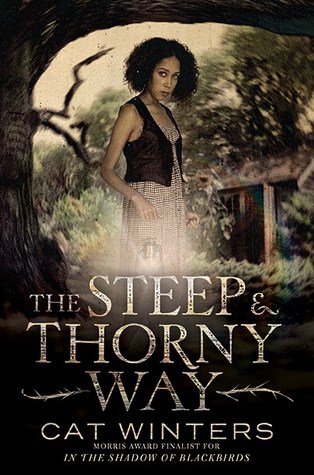Title: The Steep & Thorny Way
Author: Cat Winters
Series: N/A
Length: 352 pages
Published by: Amulet Books
Publication Date: March 8, 2016
Diversity: Biracial protagonist (half black, half white), two major gay characters, minor black character (appears only as ghost), minor Jewish character
Rating: ★★★★★
I love it when I finish a book in a day. Not just the times when I have enough hours in the day to read an entire book, but when a book sucks me in so completely that I can't imagine taking any longer than a day to finish it. And I especially love when those books take me by surprise. This was one of those books.
I was absolutely sold on this book from the minute I read the synopsis. A book inspired by Hamlet set in 1920s Oregon with a biracial female protagonist? Count me in! And then I got even more excited after I read Cat Winters's previous YA book, The Cure for Dreaming, and it was amazing.
One of the first things I loved about this book is that it makes so many references to Hamlet, and yet it was definitely its own story. A lot of the names were similar - Hannalee for Hamlet, Laurence for Laertes, Gerta for Gertrude. Fleur (Ophelia) knows a lot about the purposes of flowers and plants. Hannalee talks to the ghost of her father. And yet the character's aren't always subject to the same fates. The characters who were Hamlet's friends were sometimes replaced with Hannalee's enemies, and vice versa. And instead of the ghost of Hamlet's father urging a reluctant Hamlet to avenge him, the ghost of Hannalee's father is shocked and tries to restrain a vengeance-bound Hannalee.
After a while, this book almost entirely departs from the Hamlet plotline. Things were not what they appeared, and neither were people. A conflict that starts almost entirely within one family ends up with discussions of some of the darkest parts of Oregon history - prejudice, the Ku Klux Klan, and the eugenics movement. I learned a lot that I'm ashamed to say that I had no idea about before reading this. And these issues are not treated lightly - the book confronts the reader with how wrong things are head-on, and doesn't shy away from descriptions.
But the content alone isn't what made this book so incredible. The content may be powerful, but it's the writing that makes it really shine. I would have been moved by all of the things that I'd learned even if they were only written halfway decently. But the way these things were written moved me so deeply that I know I won't stop thinking about this book for a while.
The ending was some of the most beautiful writing in the book. So satisfying, so inspiring, and so hopeful.
Have you ever read any Hamlet retellings? Or other Shakespeare retellings? Did you like them? Are you going to read this one? Tell me in the comments!
Author: Cat Winters
Series: N/A
Length: 352 pages
Published by: Amulet Books
Publication Date: March 8, 2016
Diversity: Biracial protagonist (half black, half white), two major gay characters, minor black character (appears only as ghost), minor Jewish character
Rating: ★★★★★
I love it when I finish a book in a day. Not just the times when I have enough hours in the day to read an entire book, but when a book sucks me in so completely that I can't imagine taking any longer than a day to finish it. And I especially love when those books take me by surprise. This was one of those books.
I was absolutely sold on this book from the minute I read the synopsis. A book inspired by Hamlet set in 1920s Oregon with a biracial female protagonist? Count me in! And then I got even more excited after I read Cat Winters's previous YA book, The Cure for Dreaming, and it was amazing.
One of the first things I loved about this book is that it makes so many references to Hamlet, and yet it was definitely its own story. A lot of the names were similar - Hannalee for Hamlet, Laurence for Laertes, Gerta for Gertrude. Fleur (Ophelia) knows a lot about the purposes of flowers and plants. Hannalee talks to the ghost of her father. And yet the character's aren't always subject to the same fates. The characters who were Hamlet's friends were sometimes replaced with Hannalee's enemies, and vice versa. And instead of the ghost of Hamlet's father urging a reluctant Hamlet to avenge him, the ghost of Hannalee's father is shocked and tries to restrain a vengeance-bound Hannalee.
After a while, this book almost entirely departs from the Hamlet plotline. Things were not what they appeared, and neither were people. A conflict that starts almost entirely within one family ends up with discussions of some of the darkest parts of Oregon history - prejudice, the Ku Klux Klan, and the eugenics movement. I learned a lot that I'm ashamed to say that I had no idea about before reading this. And these issues are not treated lightly - the book confronts the reader with how wrong things are head-on, and doesn't shy away from descriptions.
But the content alone isn't what made this book so incredible. The content may be powerful, but it's the writing that makes it really shine. I would have been moved by all of the things that I'd learned even if they were only written halfway decently. But the way these things were written moved me so deeply that I know I won't stop thinking about this book for a while.
The ending was some of the most beautiful writing in the book. So satisfying, so inspiring, and so hopeful.
Have you ever read any Hamlet retellings? Or other Shakespeare retellings? Did you like them? Are you going to read this one? Tell me in the comments!

Comments
Post a Comment